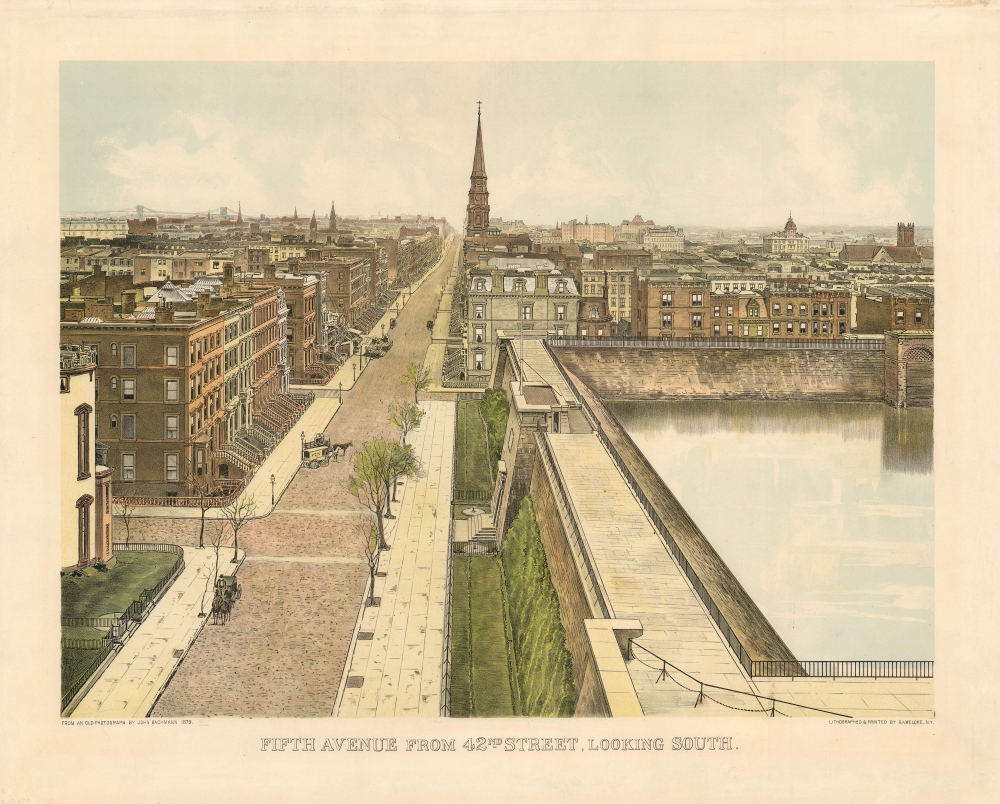1904 Welcke Lithograph View of New York's Murray Hill Neighborhood in 1879
5thAveNewYork-welcke-1904
Title
1904 (dated) 17.75 x 22 in (45.085 x 55.88 cm)
Description
A Closer Look
The southern-facing view looks down Fifth Avenue from above Forty-Second Street. The right-hand foreground is dominated by the Croton Distributing Reservoir (dismantled in the 1890s; the site is now occupied by main branch of the New York Public Library.) Its broad promenade afforded visitors nearly as good a view as the one captured in this image: Long Island, Westchester and the New Jersey Palisades could all be seen from the walls of the Reservoir. Most notable in the current view is the distant Brooklyn Bridge: although it would not open for another four years after this image’s source photograph was taken, both towers and their suspension cables had been completed and work had already begun on the superstructure. In the nearer distance, the spire of Brick Church at the corner of 37th street is recognizable. Running arrow-straight into the distance is Fifth Avenue itself: a brownstone-lined, cobblestone street with generous sidewalks and young trees planted along its length: a very different view than that of today. The youth of the neighborhood is emphasized by the constructions-in-progress.Murray Hill
The neighborhood was named after the property of the Murray family, a mercantile family that settled there in the 18th century. Up through the first half of the 19th century, the neighborhood was considered relatively isolated and remote from the rest of New York City, but as can be seen here, by the 1870s it was fully absorbed by the grid. Depending on whom one speaks to the borders of Murray Hill exhibit some fluidity but the New York Times delineation of a south-north range of 34th to 42nd streets and an east-west dimension of the East River to Madison Avenue seems the most inclusive.Publication History and Census
This lithograph was printed in 1904 by Robert Welcke, and published by Max Williams. Despite its occasional appearance on the market, it is rare: we see only one example catalogued in OCLC, in the collection of Columbia University.CartographerS
Robert A. Welcke (November 24, 1848 - January 27, 1936) was a photolithographer active in New York in the latter part of the 19th century and early 20th century. Welcke was born in Wronke, today in Poland, but then part of Prussia. He emigrated to New York City in 1869. After settling, Welcke went into the lithography business with his brother, Edward Welcke, who arrived a decade earlier. After a split between the brothers during the economic depression of the late 1870s, Robert Welcke continued in business on his own. Welcke's firm, Robert A. Welcke Offset Company, was based at 176 William Street. His corpus ranges from real estate maps of New York and Connecticut to illustrations on Flemish Renaissance interiors to government maps and brochures to decorative sheet music covers. Following Welcke's death, the firm was taken over by his daughter, Olga Welcke, who, alongside William Jugens, managed it until the outbreak of World War II (1939 - 1945). More by this mapmaker...
Max Williams (September 9, 1865 - December 5, 1927) was a German-American publisher and collector, active in New York City at the turn of the century. While he published the work of contemporaneous artists such as Robert Welcke, he is generally best known for his republishing of earlier works, in particular from Currier and Ives' original lithographic stones (Williams purchased the contents of Currier and Ives' shop upon its closing.) Williams was also apparently a collector of marine art himself, keeping a museum of nautical prints and exhibiting them to a public nostalgic for the age of sail. Learn More...
John Bachmann (1816 - May 22, 1899) was a Swiss-American landscape artist and viewmaker active in New York from the mid to late 19th century. Bachmann was born in Switzerland and apprenticed as a lithographer both in Switzerland and Paris until 1847. Like many Swiss and German printmakers, Bachmann was a Forty-Eighter, one of thousands who fled to the United States in the aftermath of the failed 'Springtime of the Peoples Revolutions of 1848'. He settled in Jersey City or Hoboken. His first publication, a spectacular view of New York City looking south from Union Square, appeared 1849. Although not the most prolific viewmaker, Bachmann is considered among the finest. He issued more than 50 views, two-thirds of which were of New York City. Bachman had a passion for New York and it's many civic advances and, unlike other viewmakers, some of his most interesting work of his work focused on these, including views of Greenwood Cemetery, Central Park, and Hoboken's Elysian Fields. He also has the distinction to be the first to use the term 'Bird's-eye' to describe his aerial-perspective views. During the American Civil War (1861 - 1865) he issued a series of innovative 'Seat of War' views illustrating the progress of the war in various theaters. These war views were revolutionary in their advanced use of perspective and orientation, to illustrate terrain and topography. His last known perspective view illustrated Havana. Bachmann's son, John Bachmann Jr. (1853 - 1927) (aka. Bachman) was also a lithographer. Learn More...

